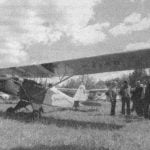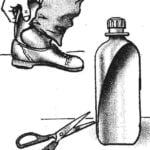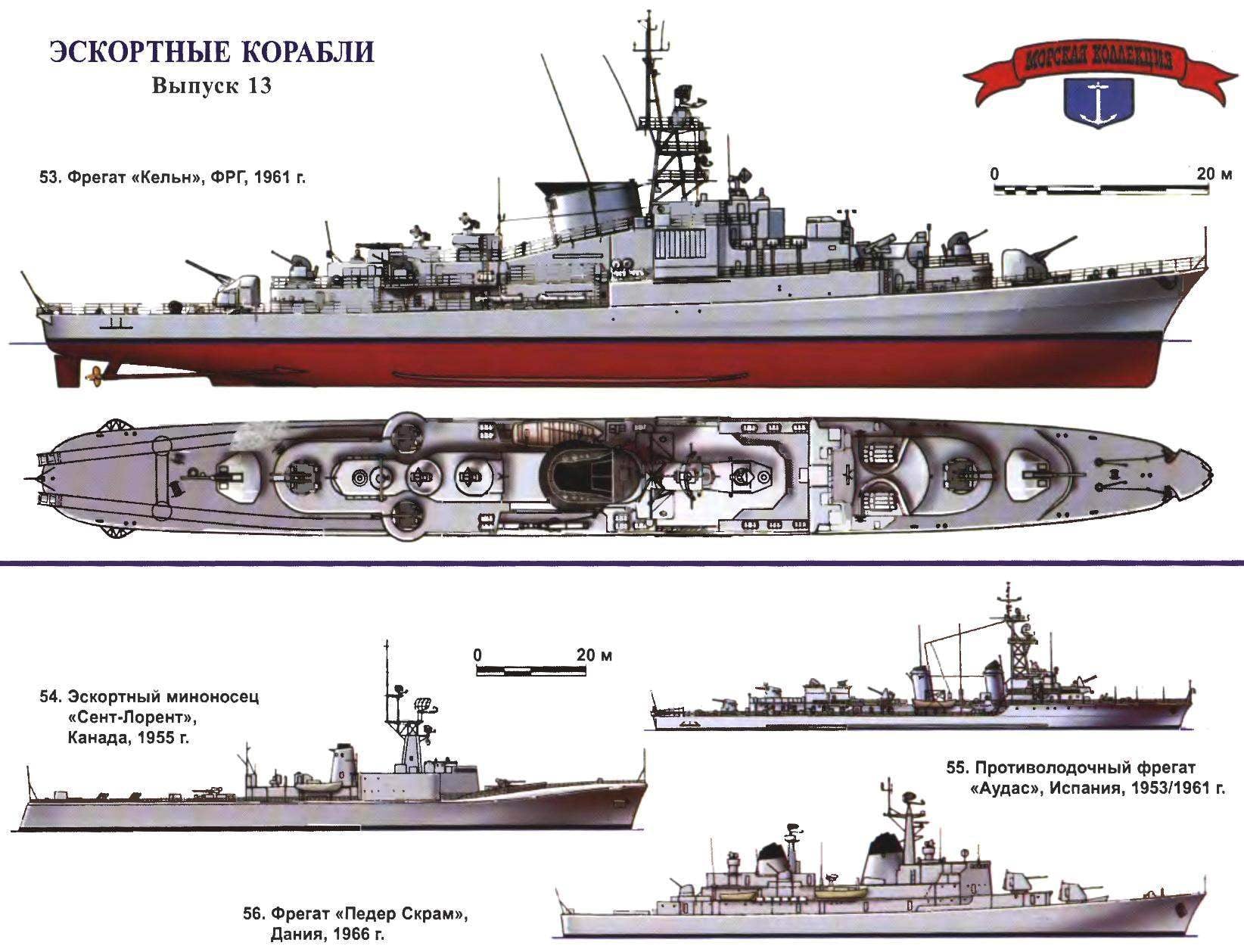 The term “shipbuilding holiday” traditionally referred to as the decade that followed the Washington conference of 1922. However, that’s hardly fair: it is precisely in those years, there was rapid development of all classes of combat ships, except battleships. It is much more appropriate to apply this concept to the 50-th years of XX century. Too large a fleet at the victorious Second world war allies and the uncertainty of the task facing him has allowed naval authorities of many States of the West and the “third world” to pause and not spend extra money on upgrading its Navy. As a result, in the next two decades, almost half of the navies of the world consisted solely of English or American second hand. Well, the countries continue to build major warships in this period, can literally be counted on the fingers.
The term “shipbuilding holiday” traditionally referred to as the decade that followed the Washington conference of 1922. However, that’s hardly fair: it is precisely in those years, there was rapid development of all classes of combat ships, except battleships. It is much more appropriate to apply this concept to the 50-th years of XX century. Too large a fleet at the victorious Second world war allies and the uncertainty of the task facing him has allowed naval authorities of many States of the West and the “third world” to pause and not spend extra money on upgrading its Navy. As a result, in the next two decades, almost half of the navies of the world consisted solely of English or American second hand. Well, the countries continue to build major warships in this period, can literally be counted on the fingers.
In 1950-ies in the number of Maritime powers, created their own and also a very good warships, entered Canada. In General, this former British dominion has long possessed a solid industrial base, but over time, the Canadians preferred to build ships for foreign (mainly English) drawings. In fact, the same policies they wanted to keep when under pressure from NATO they had to take anti-submarine defense significant areas in the Atlantic and Pacific oceans. For the sample selected seaworthy frigate of new generation “Whitby”, but the process of design in England was clearly delayed. Then the command of the canadian Navy made the decision to develop your own project. In 1949 in Montreal was organized by the design Bureau headed by chief designer R. Baker. It was under his leadership and created “Saint Laurent”— the ancestor of a large family of escort destroyers, which were highly appreciated by sailors and made effect on the development of ships of this class in other countries.
For its time, “St. Laurent” looked very unusual: because of the extensive streamlined add-ons, and the only balenoptera mast, its silhouette was called “futuristic” (Ah, would know that the then experts on the current Vogue for technology “stealth”!). A highly rounded “cherepahoobraznoy” deck in the fore part of the body— almost like destroyers half a century ago — has resulted in a good washout of the radioactive fallout that at the dawn of the atomic era was considered a very important advantage. Quite unusual for a warship looked like poop with a reverse slope transom. The Baker has attracted worldwide attention and even earned a rating of “a small masterpiece of naval architecture”.
Successful was “filling” the “Saint Laurent”. Canadians have borrowed from their older NATO partners the very best of what was created at that time. Steam turbine power plant and triple mortars “limbo” was English, all electronics, hydroacoustics and 76-mm automatic artillery — American. In the end, its anti-submarine and air capabilities of the canadian escort destroyer was superior, perhaps, any of his contemporaries, even larger and more expensive.
In 1955 and 1963, the Canadians built three slightly different series of ships of the “Saint Laurent”— a total of 18 units. The last 11 (“, Testigos” and “Mackenzie”) armed with a more powerful British 76-mm gun mounts MK-6 with a barrel length of 70 calibres (instead of 50-caliber American MK-22) and officially attributed to the class of destroyers, though, and kept them for the traditional “escort” designation DDE. And the first ships are already in 1961 began to fundamentally upgrade on them instead of one 76-mm artillery systems and mortars of the same “limbo” in the aft built a hangar and landing pad for helicopters, and the transom mounted equipment towed GUS. The original system forced landing “Bear trap” (“Bear trap”) allowed the use of heavy helicopters “sea king” — to equip such a small vehicle similar to rotorcraft technology, the Canadians succeeded for the first time.
The experience gained helped to improve the original draft, and the last two ships of the family— “Annapolis” and “Nipigon”, which came into operation in 1964 — initially had a helicopter hangar and towed GUS and two three-pipe apparatus for anti-submarine torpedoes. In addition, they once again replaced the artillery of the main caliber was back in the us, but more modern 76 mm coaxial gun mount, the MK-33.
Further development of the project “Saint Laurent” was the destroyer-helicopter “Iroquois”, one of the best anti-submarine ships of his time in the combat ranks of the canadian Navy to this day (see “modelist-Konstruktor” No. 12 of 2002). Even the escort destroyers were long, repeatedly upgraded and have proven themselves from the best side. Most of them were withdrawn from combat composition of the fleet in 1990-e years, and the last two referred to “Annapolis” and “Nipigon”, survived until the beginning of the XXI century.

53. The frigate “köln”, Germany, 1961
Built at the shipyard “Stalken” in Hamburg. Displacement standard 2090 t, full 2750 t maximum Length of 109.8 m, width 11 m, draft 4,6 m. Capacity twin-shaft diesel-gas turbine plant 36 000 HP, speed 32 knots. Armament: two 100-mm automatic guns, six 40 mm guns, four 553-mm torpedo tubes ASW, two six-barreled 375-mm RBU “Bofors”. Just built 6 units.
54. Escort destroyer “St. Laurent”, Canada, 1955
Built at the shipyard “Canadian Vickers”. The standard displacement of 2000 tons, full 2600 t maximum Length of 111.6 m, width-12,8 m, draft 4.2 m. Capacity twin-shaft steam turbine 30 000 HP, speed 28 knots. Armament: four 76-mm automatic cannon, two 40-mm machine gun, two triple mortars “limbo”. Only in 1955 — 1964 20 built a few different units.
55. Anti-submarine frigate “Audas”, Spain, 1953/1961 G.
Built at the shipyard in Ferrol. Displacement standard 1227 t, t 1548 full Length the greatest 93,9 m, width 9.4 m, draught 3 m. Capacity twin-shaft steam turbine 30 800 HP, speed 31.6 per node. Armament: two 76-mm guns, two 40-mm machine gun, two RBU “Hedgehog”, 8 mortars and 2 of the release gear. Built only 9 units.
56. The frigate “Peder skram”, Denmark, 1966
Built at the shipyard in helsingør. The standard displacement of 2200 tons, full 2720 m. the Length greatest in 112.6 m, width 12 m, draft 4.3 m. Capacity twin-shaft diesel-gas turbine unit 37 000 HP, speed 28 knots. Armament: four 127-mm guns, four 40-mm machine gun, one three-pipe 533-mm torpedo tubes. Just built 2 units.
In Europe, one of the few countries who continued in the 1950-ies to actively build the ships at its own shipyards, was Spain. However, if the canadian escortsite can rightly be considered among the best in its class, the Spanish could claim only for the worst. And no wonder: support for the regimes of Hitler and Mussolini brought the dictator Franco in the postwar years to the political and economic isolation. Devoid of any outside support of the Spanish industry had to rely only on themselves. This could not affect the implementation of the shipbuilding programs. Allow enough eloquent fact: two destroyers of the type “Alava”, which entered into operation in 1950 — 1951, in fact represented only a slightly improved draft during the first world war! Of course, no value in these “modern” units of the Navy are not represented. Not many looked better, and nine destroyers of the “Audas”, founded in 1945 at the shipyard in Ferrol. They are strongly reminiscent of pre-war French destroyers, drawings are given in the form of a trophy to the Germans and unnecessary “fused” in a friendly Spain…
The escalation of the cold war between the West and the Soviet Union for General Franco proved to be very helpful. On the background of the “Communist threat”, NATO began to consider Spain as a strategic ally against the ruling where the regime of its “non-democratic”. In 1953 the Madrid and Washington entered into an important agreement, whereby in exchange for technical assistance the United States was granted military bases on the Peninsula. Franco immediately began to update its armed forces, including Navy.
No. 57. The mother ship “Rhine”, Germany, 1961
Built at the shipyard “Slip” in Hamburg. Displacement standard, t 2370, 3010 full t maximum Length of 98.2 m, width 11,8 m, draft 5,2 m. Capacity twin-shaft diesel installation 11 400l.. speed 22 knots. Armament: two 100-mm automatic guns, four 40-mm machine gun. Built only 13 units.
A special role was assigned escort ships. All destroyers types of “Alava” and “Audas”, already built, and not yet entered service, was rebuilt into a fast anti-submarine frigates. So, they completely removed the old arms and installed new, American-style. Now instead of 120-mm and 105-mm guns these ships carried two or three 76-mm gun, antiaircraft machine guns, mortars and release gear, including reactive “Hedgehog”. Appeared radar, sonar and fire control system, and for larger antennas, radar masts steel lattice. In General, modernization has allowed some to “modernize” the Spanish ships, but still by the time of completion of the works (1965), they were clearly obsolete. Not surprisingly, most of them served in new as little as 10 years or longer.
In the mid-1950s began the revival of the fleet of Germany. The first swallows Bundesmarine became the frigates of the “Cologne” or, as they were called at the stage of project development, escort ships “55”. They were ordered in March 1957 and for the time looked good. The frigates had a combined power plant (gas turbine used for full stroke and diesel engines — economic), a very decent radar and sonar equipment. The main guns were French automatic 100 mm cannon is the best artillery systems available in the West in those years. It was impressive and anti-submarine armament: two 375-mm rocket mortar of the Swedish company “Bofors” and four single-tube 533-mm torpedo tubes for ASW torpedoes. However, experts noted that the ships of the “Cologne” was overloaded with weapons, and this left the reserves for further upgrades. Moreover, the construction of the entire series of six units was completed in 1964, and requirements for escort vehicles very soon changed…
Speaking about the first West German frigates, not to mention the so-called “mother ships” type “Rhine”. In the beginning of 1960-ies was commissioned from 13 (!) these ships, officially considered auxiliary vessels. In reality, this was a typical frigate, similar in architecture to the “Cologne” and had almost the same composition artillery weapons. Their powerplant, which included six diesel engines, has maintained a very good pace in 22 — 22.5 hub. To the class of mother ships (Begleitschiffe) the ships of the “Rhine” brought solely for political reasons — so as not to annoy the public too rapid growth of the German Navy.
After Germany’s own frigates acquired and Denmark. “Peder skram and Herluf Troll” were the last major artillery ships of its class West European fleets. As the West German “Cologne”, they were equipped with combined diesel-gas turbine power plant, but differed very unusual armament. As the main caliber of the Danes for some reason chose American 127-mm universal guns during the Second world war, and both two-gun turret mounted in the forward part of the linear sublime, as destroyers of the type “A. Sumner” — “Geared”. Massive towers, high superstructure, twin chimneys — all this gave the Danish frigates impressive appearance. But overall, the project was not too successful. Only in the course of modernization 1976 — 1978, when the ships lost one of the 127-mm of towers and were armed with missiles “Harpoon” and “sea Sparrow”, their performance characteristics, acquired, finally, a certain harmony.
S. BALAKIN
Recommend to read
 “PERSISTENT” ASKS IN THE FLIGHT
“PERSISTENT” ASKS IN THE FLIGHT
So call your plane the club-model airplanes and their leader — Vadim B. Rumyantsev from the city of Privolzhsk, Ivanovo region, whose hands at the local station of young technicians... SPOON…BOTTLE
SPOON…BOTTLE
Any application not find the large plastic bottles of mineral water and other beverages. I want to offer another option — to cut out such a Shoe spoon helps to wear tight shoes. S....
 The term “shipbuilding holiday” traditionally referred to as the decade that followed the Washington conference of 1922. However, that’s hardly fair: it is precisely in those years, there was rapid development of all classes of combat ships, except battleships. It is much more appropriate to apply this concept to the 50-th years of XX century. Too large a fleet at the victorious Second world war allies and the uncertainty of the task facing him has allowed naval authorities of many States of the West and the “third world” to pause and not spend extra money on upgrading its Navy. As a result, in the next two decades, almost half of the navies of the world consisted solely of English or American second hand. Well, the countries continue to build major warships in this period, can literally be counted on the fingers.
The term “shipbuilding holiday” traditionally referred to as the decade that followed the Washington conference of 1922. However, that’s hardly fair: it is precisely in those years, there was rapid development of all classes of combat ships, except battleships. It is much more appropriate to apply this concept to the 50-th years of XX century. Too large a fleet at the victorious Second world war allies and the uncertainty of the task facing him has allowed naval authorities of many States of the West and the “third world” to pause and not spend extra money on upgrading its Navy. As a result, in the next two decades, almost half of the navies of the world consisted solely of English or American second hand. Well, the countries continue to build major warships in this period, can literally be counted on the fingers.




